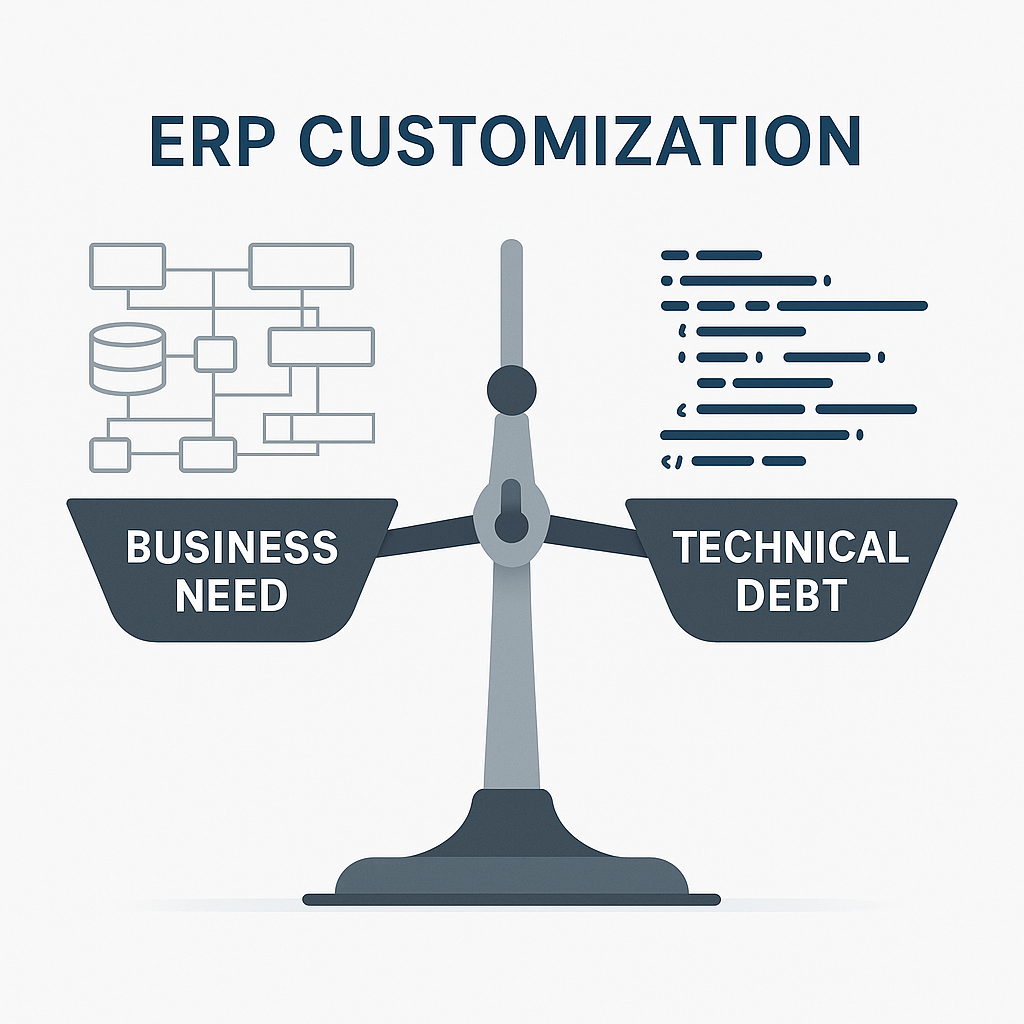
Table of Contents
It’s one of the great tug-of-wars in any enterprise technology implementation, isn’t it? On one side, you have the business, with its unique processes and a legitimate need for the ERP system to work for them. On the other, you have the technology team, rightly concerned about the long-term consequences of extensive customization: upgrade headaches, maintenance burdens, and the slow, creeping accumulation of technical debt. My years of experience navigating this exact tension across countless system deployments have shown me one thing clearly: the debate isn’t about if you should customize, but how and why.
Many organizations approach ERP customization with a tactical mindset, solving immediate problems without fully appreciating the long-term architectural price. A perspective forged through this experience suggests that a more strategic, governance-driven approach is essential for sustainable success.
Deconstructing “Customization”: It’s Not All the Same
First, let’s be precise. The term “customization” is often used as a catch-all, but there are important distinctions. We need to differentiate between:
- Configuration: Using the ERP’s built-in tools to tailor the system (e.g., setting up workflows, creating custom fields, designing report layouts). This is generally low-risk and fully supported.
- Personalization: Allowing users to change their own interface or experience without affecting the underlying logic. Also very low-risk.
- Extension (or Extensibility): Building new functionality on top of the platform’s development framework, often using a vendor’s approved tools (like NetSuite’s SuiteScript or Salesforce’s Apex). This is where the risk starts to climb.
- Modification: Directly altering the core source code of the ERP. This is the riskiest path and is thankfully becoming rare in the cloud ERP era, but it was common in older on-premise systems and the source of many upgrade nightmares.
The most critical governance challenge lies with extensions. This is where the line between value-adding enhancement and unsustainable technical debt becomes blurred.
A Framework for Making Smarter Customization Decisions
So how do you make the right call? Instead of an ad-hoc process, a structured evaluation framework is needed. When a business unit requests a customization, the conversation should be guided by a few key questions:
What is the true business value? Can we quantify the benefit? Will this customization drive revenue, reduce significant costs, or mitigate a material risk? If the answer is vague, it’s a red flag.
Is there a standard process we can adopt? This is often the toughest question. Does this process truly represent a unique competitive advantage, or is it just “the way we’ve always done it”? Adopting a standard, out-of-the-box process, even if it requires some operational change, is often the more prudent long-term choice.
What is the Total Cost of Ownership (TCO)? The cost isn’t just the initial development. What’s the estimated cost of maintaining this customization over a 5-7 year period, including through at least two major platform upgrades? This TCO analysis often changes the conversation dramatically.
What is the architectural impact? Does this customization create complex dependencies? Does it rely on unstable integration points? Will it impact system performance?
Insights distilled from numerous complex system deployments indicate that organizations with a formal governance body (a cross-functional team of business and IT leaders who review and approve customizations against such a framework) make far more sustainable choices.
Managing Technical Debt as a Strategic Asset
The Inevitable Reality of Technical Debt
Even with the best governance, some customization is often necessary. This means every enterprise must accept and manage a certain level of technical debt. The key is to make this debt intentional and visible.
This involves a few mature practices. First, documenting every customization meticulously, not just what it does, but why it was approved. Second, maintaining a centralized customization inventory or registry. Third, periodically reviewing this inventory to identify customizations that are no longer needed or could be replaced by new, standard functionality released by the ERP vendor.
This proactive management transforms technical debt from a hidden, creeping risk into a managed liability on your technical balance sheet. It’s the difference between a planned, low-interest loan and a high-interest credit card spiraling out of control.
Ultimately, the goal isn’t to eliminate customization entirely. It’s to ensure that every customization decision is a conscious, strategic choice that delivers clear business value that outweighs its long-term cost. The most successful and agile organizations I’ve observed aren’t those with the fewest customizations, but those with the most disciplined and strategic approach to managing them.
For further discussion on enterprise system strategy, I invite you to connect with me on LinkedIn.